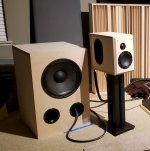Hi Mainframe,
Are you saying that the Bliesema now is no longer lacking the top end “air and sparkle” you mentioned earlier or it just was never an issue, really.
I never got around to making the foamcore pathfinder/prototype. Will go straight to BB ply - my cabinet maker has started already. I am sending him drivers to get a Perfect fit (despite my best efforts to specify in a drawing - nothing beats having drivers in hand).
Here is what it’s going to look like:
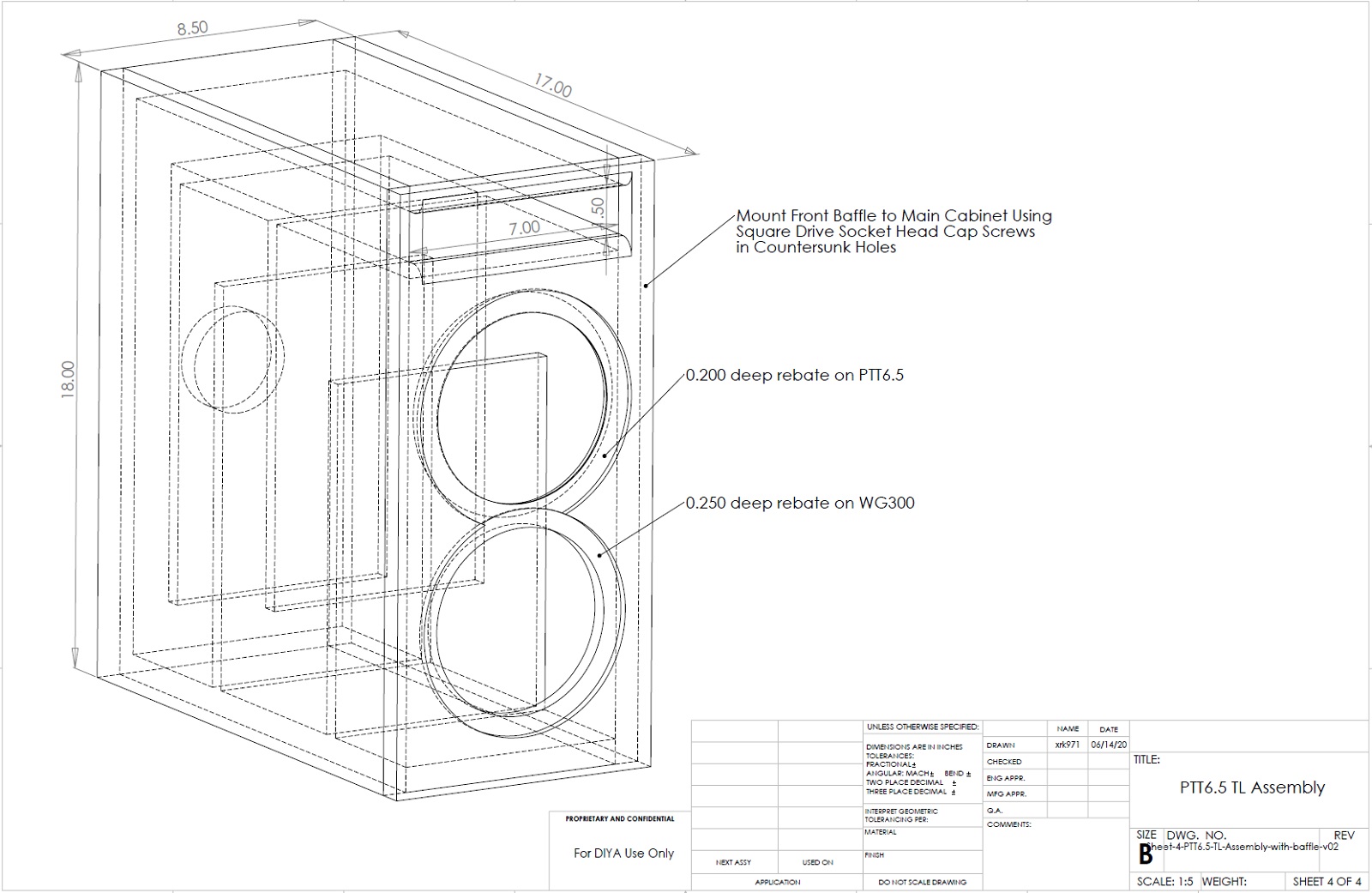
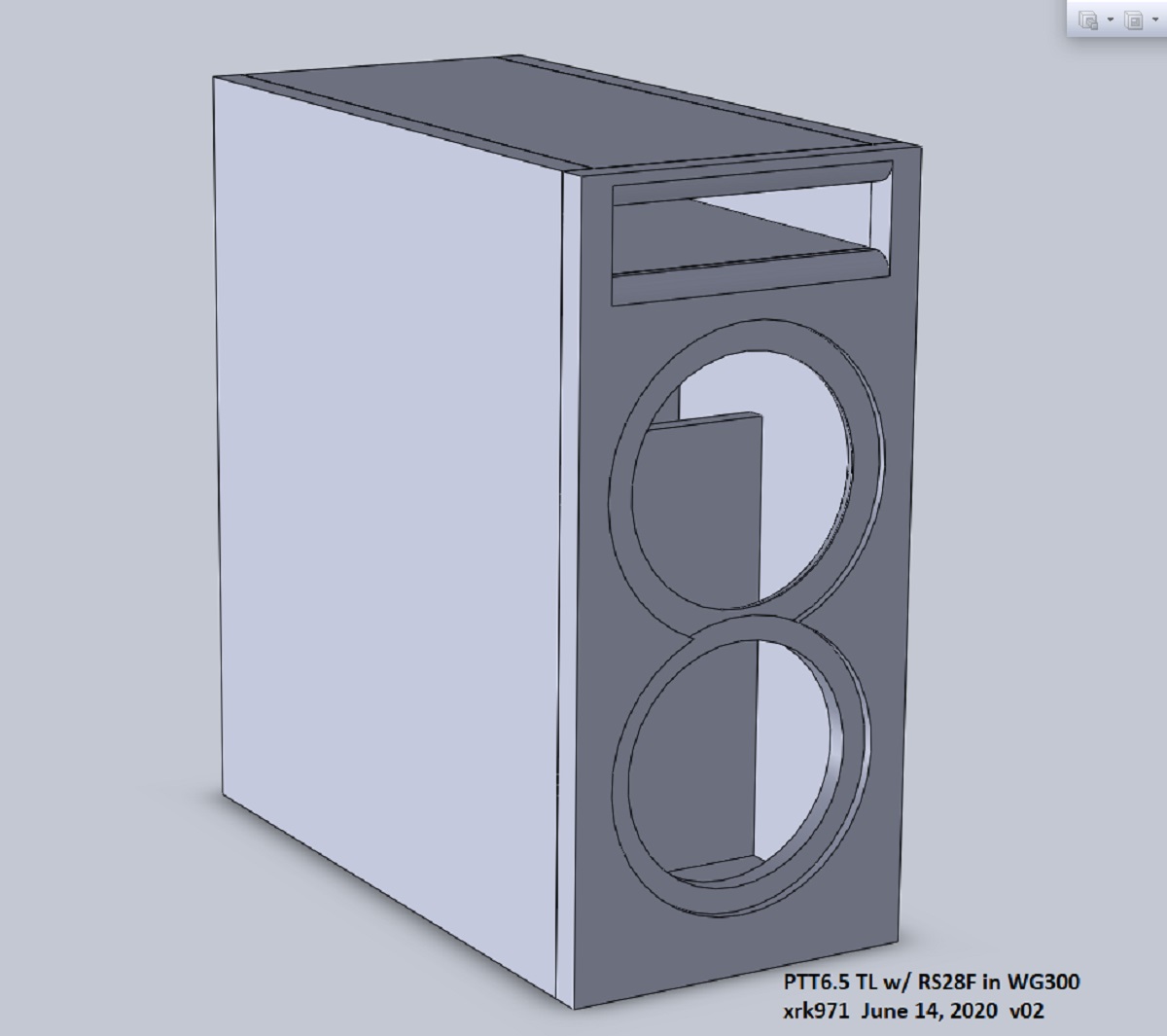
Are you saying that the Bliesema now is no longer lacking the top end “air and sparkle” you mentioned earlier or it just was never an issue, really.
I never got around to making the foamcore pathfinder/prototype. Will go straight to BB ply - my cabinet maker has started already. I am sending him drivers to get a Perfect fit (despite my best efforts to specify in a drawing - nothing beats having drivers in hand).
Here is what it’s going to look like:
It wasn't really an issue - it was just nitpicking. It does show in my 20mm measurements of the drivers (vs the sb26adc) however so I wasn't going full head-fi. My hearing is good to 16K still, and there'd be 3db difference between the two at that Hz IIRC, which doesnt show on online measurements. Will check again when home
That's a bad-*** TL box. Hope that hard work pays off. I still cant believe how revealing the purifi driver is after all this time.
That's a bad-*** TL box. Hope that hard work pays off. I still cant believe how revealing the purifi driver is after all this time.
Well, as erniem says this only makes sense as a desktop monitor where you absolutely can't go bigger and for whatever reason don't want to add a sub. Or maybe a hypothetical uber-high-end soundbar. My comment was aimed at using it as a midrange in a 3-way, which was my initial thought as to why you'd want something smaller than the 6.5.
So, $300 to anchor a 4" standalone desktop monitor seems like a market so limited as to almost not exist.
The small speaker market is bigger than you think and this is not the driver you'd turn to for use as mid.
..unless you want it for sound reinforcement (or any very high spl application) and have lots of power to draw from. I could also see it as a lower mid driver for no-baffle use (..again, with a lot of power for pressure loss compensation).
The small speaker market is bigger than you think and this is not the driver you'd turn to for use as mid.
Sure, the small speaker market is big. I'm not so sure about the ultra-high-end small speaker market, though. How many people are looking to spend $1.5-$2k+ on a 4" based speaker but are simultaneously constrained from either a bigger speaker or a sub? Maybe a mini Devialet Phantom or something. It just seems awfully niche.
Maybe the high-end soundbar market might actually make sense. It certainly would be an application where you can't easily go bigger., and subs are problematic. Still seems a bit expensive, but who knows that the volume discount rate would be.
Sure, the small speaker market is big. I'm not so sure about the ultra-high-end small speaker market, though.
"Ultra-high-end" might be an exaggeration. The drivers are not THAT expensive, especially after volume discount.
I see the 6.5" as probably the best choice out there for a mini studio monitor and for any high-end domestic compact speaker though it is more likely to work in the former application than the latter due to the 'ugly duckling' looks of the surround.
The small speaker market is bigger than you think and this is not the driver you'd turn to for use as mid.
So, if you were using the PTT6.5 as a (mid)woofer and a high-end tweeter and wanted a midrange between them, what would you choose? Say, no bigger than 5" and less than $600 for a pair.
So, if you were using the PTT6.5 as a (mid)woofer and a high-end tweeter and wanted a midrange between them, what would you choose? Say, no bigger than 5" and less than $600 for a pair.
I'd go with a pair of the 8ohm purifi and a satori 5" mid maybe.
I'm going two-way with the 9900 to start, something old and something new.
I tried a Bliesma T25B-6 + PTT6.5 as mid-woofer + a JBL 15" as the woofer. crossing at 2.5k and 120Hz. Sounds amazing. As capable as the 6.5" Purifi is, there is no competition to a 15" JBL. As the good saying goes, there is no replacement for displacement.
Last edited:
Speakers or sports cars one eventually finds the limits. One of the nice things about HiFi is exceeding the limits does not involve flying off curves into oak trees.
For one of our Thursday’s audiophile nights with my friends Leo and Michael we were listening to my Purifi equipped Fi16v1s. I selected the sonic spectacular Reference Recordings’ “Stravinsky: The Rite of Spring, etc.” featuring Eiji Oue conducting the Minnesota Orchestra. I queued up the 7 tracks of The Firebird Suite hit play and we sat back, eventually quit talking, and listened. The average level of this very wide dynamic range recording is unusually low so I had the system gain turned up. Michael asked for a further level increase and I obliged.
Listening to the quiet melodic suite “Round Dance of the Princesses” (track 4) while enjoying the iconic melody played by flute soloist and string section I was also pleased to note how well the Fi16v1 was ‘illuminating’ the concert hall size by reproducing the quiet bowing and plucking of the strings’ bass section. I also noticed from the incidental noises like the musician’s music stands or chairs creaking we were listening at levels considerably above how loud the orchestra is in the concert hall. Knowing what was ahead I considered reducing volume but decided to continue. Immediately as the next suite “Infernal Dance of King Kashchei” (track 5) starts the strongest percussionist in the company hits the biggest bass drum the orchestra owns as hard as humanly possible. As an added bonus this talented musician performed that hit and the next 6 hits at the exact moments Igor and Eiji directed for maximum musical impact.
The Purifi PTT6.5W04 woofers and PTT6.5PR passive radiators in my Fi16v1s were not entirely happy with this turn of events. Very loud very deep bass was accompanied by some audible distress. Executing the classic owner jumps for volume control maneuver damage was averted. Volume reduced to actual levels in the concert hall and the track was repeated to great effect sans distortion.
Intrigued by the technical side of this a few days later I loaded the track into Adobe Audition for analysis. My copy is the HDCD 44k 16 bit version. The drum hit that sent me leaping for the volume control peaks at –0.8 dB. The quiet transition just before is as low as –42 dB! Averaging the first 400 mS of track 5 it is quieter that –30 dB just before the leap to –0.8 dB. In the frequency domain the fundamental seen in the waveform during the drum hit is right at 20 Hz and I see lesser amplitude turns of the wave that imply harmonic energy at 10 Hz. In the first 32 seconds of track 5 there are seven of these massive drum hits scaled to just below digital 0 dB clipping. If this is your first time down the rabbit hole of numerical analysis of music recordings let me assure you finding over 30 dB of dynamic range is extremely rare, and marvelous and a bit dangerous. Also recall that in this context of a digital recording 0 dB is the absolute maximum where all the bits of the sample are ‘on’. That is why the mastering engineer has scaled to just below 0 dB i.e. the –0.8 dB I observed. If Eiji Oue and Minnesota Orchestra were performing this live and we assume the Round Dance of the Princesses is played at 70 dB then the bass drum hits in Infernal Dance of King Kashchei will peak at 100 dB.
With those numbers in mind I got out my SPL meter and set it to ‘C weighting’ and ‘Fast Response’. On a quiet Sunday afternoon the background noise level in my suburban home registers 50 dB when the HVAC is off 56 to 58 dB with AC cycled on. Thus playing the Princesses track with the SPL meter reading 60 to 66 dB sounds very natural and concert hall appropriate. When King Kashchei comes banging in SPL readings peak at 96 to 97 dB with no audible distortion and demo quality reproduction of those loud deep bass hits.
I hope this long post will help place the bass capabilities of the Purifi PTT6.5 drivers in context. Their bass is amazing, but like all things finite. Full reproduction of orchestral bass with content below 30 Hz at levels approaching 100 dB from a 0.6 cu ft / 16 liter box qualifies as amazing in my book. I continue to believe Purifi’s breakthroughs in lowering distortion are also a big part of the bass quality delivered.
Will this be enough for everyone? No. Exploring the HiFi videos on YouTube I recently watched some home theater enthusiasts who documented upgrading home theaters from pairs of 15” woofer equipped subwoofers to 18” subs. These subs were driven by 3000 watt pro-sound amplifiers with DSP EQ measured and adjusted flat to 10 Hz. The upgrade kept the 15” subs and ADDED(!) the 18”. Results included bragging about 160 dB SPLs and ceiling panels breaking loose and falling on guests. I am sure that is fun (perhaps not for chap under falling ceiling) to hear/feel but (here comes the dad/granddad comment) the resulting hearing loss and tinnitus is not so fun. Point is bass is like horsepower, someone is always going to want more and then More and then MORE. Personally I continue to find Purifi PTT6.5 bass more than adequate, thrilling, and a significant advance of the state of the art.
Previous reports on my Fi16v1 speaker:
https://www.diyaudio.com/forums/multi-way/352063-exploring-purifi-woofer-speaker-builds-10.html#post6196918
https://www.diyaudio.com/forums/multi-way/352063-exploring-purifi-woofer-speaker-builds-13.html#post6209421
For one of our Thursday’s audiophile nights with my friends Leo and Michael we were listening to my Purifi equipped Fi16v1s. I selected the sonic spectacular Reference Recordings’ “Stravinsky: The Rite of Spring, etc.” featuring Eiji Oue conducting the Minnesota Orchestra. I queued up the 7 tracks of The Firebird Suite hit play and we sat back, eventually quit talking, and listened. The average level of this very wide dynamic range recording is unusually low so I had the system gain turned up. Michael asked for a further level increase and I obliged.
Listening to the quiet melodic suite “Round Dance of the Princesses” (track 4) while enjoying the iconic melody played by flute soloist and string section I was also pleased to note how well the Fi16v1 was ‘illuminating’ the concert hall size by reproducing the quiet bowing and plucking of the strings’ bass section. I also noticed from the incidental noises like the musician’s music stands or chairs creaking we were listening at levels considerably above how loud the orchestra is in the concert hall. Knowing what was ahead I considered reducing volume but decided to continue. Immediately as the next suite “Infernal Dance of King Kashchei” (track 5) starts the strongest percussionist in the company hits the biggest bass drum the orchestra owns as hard as humanly possible. As an added bonus this talented musician performed that hit and the next 6 hits at the exact moments Igor and Eiji directed for maximum musical impact.
The Purifi PTT6.5W04 woofers and PTT6.5PR passive radiators in my Fi16v1s were not entirely happy with this turn of events. Very loud very deep bass was accompanied by some audible distress. Executing the classic owner jumps for volume control maneuver damage was averted. Volume reduced to actual levels in the concert hall and the track was repeated to great effect sans distortion.
Intrigued by the technical side of this a few days later I loaded the track into Adobe Audition for analysis. My copy is the HDCD 44k 16 bit version. The drum hit that sent me leaping for the volume control peaks at –0.8 dB. The quiet transition just before is as low as –42 dB! Averaging the first 400 mS of track 5 it is quieter that –30 dB just before the leap to –0.8 dB. In the frequency domain the fundamental seen in the waveform during the drum hit is right at 20 Hz and I see lesser amplitude turns of the wave that imply harmonic energy at 10 Hz. In the first 32 seconds of track 5 there are seven of these massive drum hits scaled to just below digital 0 dB clipping. If this is your first time down the rabbit hole of numerical analysis of music recordings let me assure you finding over 30 dB of dynamic range is extremely rare, and marvelous and a bit dangerous. Also recall that in this context of a digital recording 0 dB is the absolute maximum where all the bits of the sample are ‘on’. That is why the mastering engineer has scaled to just below 0 dB i.e. the –0.8 dB I observed. If Eiji Oue and Minnesota Orchestra were performing this live and we assume the Round Dance of the Princesses is played at 70 dB then the bass drum hits in Infernal Dance of King Kashchei will peak at 100 dB.
With those numbers in mind I got out my SPL meter and set it to ‘C weighting’ and ‘Fast Response’. On a quiet Sunday afternoon the background noise level in my suburban home registers 50 dB when the HVAC is off 56 to 58 dB with AC cycled on. Thus playing the Princesses track with the SPL meter reading 60 to 66 dB sounds very natural and concert hall appropriate. When King Kashchei comes banging in SPL readings peak at 96 to 97 dB with no audible distortion and demo quality reproduction of those loud deep bass hits.
I hope this long post will help place the bass capabilities of the Purifi PTT6.5 drivers in context. Their bass is amazing, but like all things finite. Full reproduction of orchestral bass with content below 30 Hz at levels approaching 100 dB from a 0.6 cu ft / 16 liter box qualifies as amazing in my book. I continue to believe Purifi’s breakthroughs in lowering distortion are also a big part of the bass quality delivered.
Will this be enough for everyone? No. Exploring the HiFi videos on YouTube I recently watched some home theater enthusiasts who documented upgrading home theaters from pairs of 15” woofer equipped subwoofers to 18” subs. These subs were driven by 3000 watt pro-sound amplifiers with DSP EQ measured and adjusted flat to 10 Hz. The upgrade kept the 15” subs and ADDED(!) the 18”. Results included bragging about 160 dB SPLs and ceiling panels breaking loose and falling on guests. I am sure that is fun (perhaps not for chap under falling ceiling) to hear/feel but (here comes the dad/granddad comment) the resulting hearing loss and tinnitus is not so fun. Point is bass is like horsepower, someone is always going to want more and then More and then MORE. Personally I continue to find Purifi PTT6.5 bass more than adequate, thrilling, and a significant advance of the state of the art.
Previous reports on my Fi16v1 speaker:
https://www.diyaudio.com/forums/multi-way/352063-exploring-purifi-woofer-speaker-builds-10.html#post6196918
https://www.diyaudio.com/forums/multi-way/352063-exploring-purifi-woofer-speaker-builds-13.html#post6209421
I tried a Bliesma T25B-6 + PTT6.5 as mid-woofer + a JBL 15" as the woofer. crossing at 2.5k and 120Hz. Sounds amazing. As capable as the 6.5" Purifi is, there is no competition to a 15" JBL. As the good saying goes, there is not replacement for displacement.
I am curious how large is the box for the 15" JBL?
The Michael I mentioned above uses GR Research servo subs another more bass More bass MORE bass option where the cone area and servo amps help mitigate the distortion effects Purifi goes after.
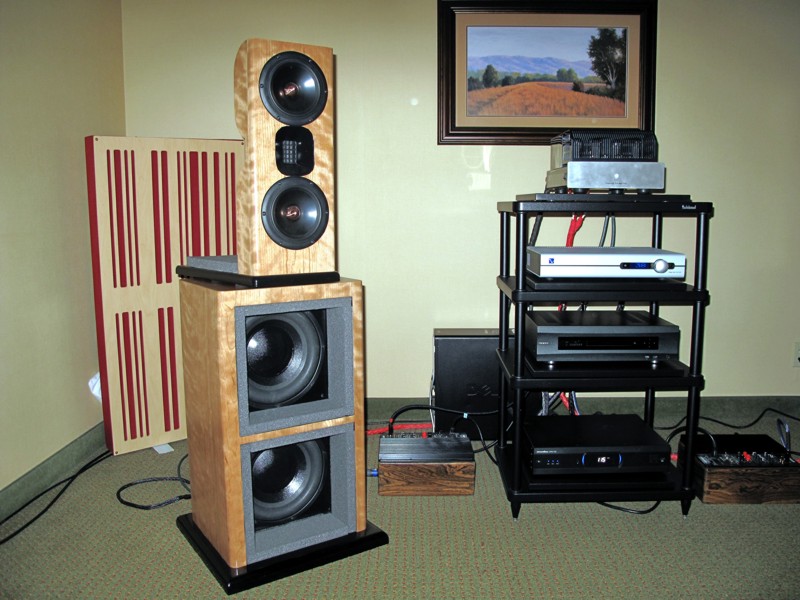
GR Research's dipole plus servo technology is one of the few I would guess that could keep up with a PTT6.5. Especially if space allows scaling it up a bit like Danny Richie's 3 x 12" per side array.
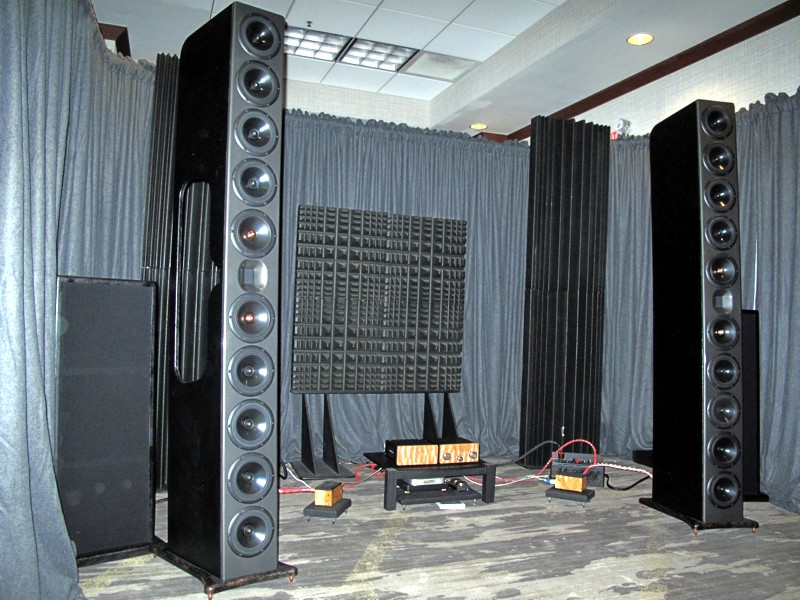
GR Research NT-Xtreme speakers with Servo Sub 5 subwoofers
Thank you for the thoughtful write up, Norman. I’ll have to try that recording out. 40dB DR is extremely rare in recordings.
I am curious how large is the box for the 15" JBL?
The Michael I mentioned above uses GR Research servo subs another more bass More bass MORE bass option where the cone area and servo amps help mitigate the distortion effects Purifi goes after.
6.5 cu ft. it takes up quite a bit of space!
I am familiar with the GR subs. Although never heard them in person, I follow the posts in the audiocircle forum. Very curious to try them but I am honestly running out of space in my room at the moment. In fact, I had planned to pay a visit to Dannie this month but all travelling plans was put aside due to the current situation.
I just have to wonder if we even need the GR subs if we have an array of 10 Purifi's on each side!
Attachments
Last edited:
a small digression again.
I was sitting at the Royal Opera House last December listening to La Traviata, we had good seat at row 9, a couple of seats from the center on the right side. What I noticed was that, at the passage in "Alfredo! Voi!.. Or tutti a me..." the staccato bass coming out from the double bass and cello section was not loud. It was clear, fast, and very crisp yet deep. Nothing like what we get from loudspeakers. I also recorded the sound level and compare it to my usual listening level, it is not loud at all. However, if i try to listen at that same level from my previous loudspeakers, the bass will be boring and liveless.
I am starting to get that type of sound from the Purifi as mid woofer + JBL, but still not close.
Another digression, I have a friend who has a 2x 18" + 2x 15" on each side (ie. 4 of each total) driven by high power crown amps. His system came up with dynamics that is closer to live. It was not played loud, it was just deep and quick and defined. But still not like live orchestral music.
I was sitting at the Royal Opera House last December listening to La Traviata, we had good seat at row 9, a couple of seats from the center on the right side. What I noticed was that, at the passage in "Alfredo! Voi!.. Or tutti a me..." the staccato bass coming out from the double bass and cello section was not loud. It was clear, fast, and very crisp yet deep. Nothing like what we get from loudspeakers. I also recorded the sound level and compare it to my usual listening level, it is not loud at all. However, if i try to listen at that same level from my previous loudspeakers, the bass will be boring and liveless.
I am starting to get that type of sound from the Purifi as mid woofer + JBL, but still not close.
Another digression, I have a friend who has a 2x 18" + 2x 15" on each side (ie. 4 of each total) driven by high power crown amps. His system came up with dynamics that is closer to live. It was not played loud, it was just deep and quick and defined. But still not like live orchestral music.
Qobuz nicely carries the Oue performance of Firebird. Goodness you are brave to try that on the Purifi! With just normal volume it was so loud that the JBL 15" woofer shook my whole room. 20x20x9. Without much strain I must say. I would never risk hitting the Purifi's Xlim on that!
Having said that, it does sound quite good!
Having said that, it does sound quite good!
Hello,
this topic has been interesting me at great length.
Considering a 2-way build with these, but struggling with the question how to determine the time-alignment between woofer and tweeter in DSP.
Does one align them at maximum inward excursion, the middle, or the maximum outward excursion? It seems that this can differ as much as 10mm. With my listening distance, a difference of 2mm in DSP setting is audible.
Picturing a kitesurfer with sticks instead of ropes for his kite. A way to measure the non-axial tension on the sticks would be nice, how would one determine the required method?
this topic has been interesting me at great length.
Considering a 2-way build with these, but struggling with the question how to determine the time-alignment between woofer and tweeter in DSP.
Does one align them at maximum inward excursion, the middle, or the maximum outward excursion? It seems that this can differ as much as 10mm. With my listening distance, a difference of 2mm in DSP setting is audible.
Picturing a kitesurfer with sticks instead of ropes for his kite. A way to measure the non-axial tension on the sticks would be nice, how would one determine the required method?
To me, the Harsch XO sounds best for time alignment when using DSP. It’s quasi transient perfect and allows higher order filters to be used.
S. Harsch XO
I think Mainframe I using it on his build. I am using it (passive XO).
S. Harsch XO
I think Mainframe I using it on his build. I am using it (passive XO).
So, if you were using the PTT6.5 as a (mid)woofer and a high-end tweeter and wanted a midrange between them, what would you choose? Say, no bigger than 5" and less than $600 for a pair.
Honestly, if it were me I don't think I would. IMHO the Purifi value proposition only makes sense if crossed directly to an appropriate tweeter, and either run as a 2-way with good extension, or else crossed to a sub for a very high output system. Adding a mid and only using the Purifi up to 5/600 doesn't seem to be playing to it's unique strengths. I'd take the $600 from the mids and put towards the SB Waveguide BE tweeter for example - cross at 1.8kHz and don't look back.
Yes, the strength of the Purifi is a small two way low extension woofer.
Maybe cross to a sub at 60-80 for high SPL design - this would be another option.
but there is something for a high SPL 4 way Low distortion system.
The purify is at it's best distortion wise between 100-1200 or so. So having a small mid 3-4" playing from about 1k to 4-5k and crossing over to a small tweeter can take advantage of it. This should also have better dispersion characteristics.
And multiple subwoofers to tackle the low end.
Maybe cross to a sub at 60-80 for high SPL design - this would be another option.
but there is something for a high SPL 4 way Low distortion system.
The purify is at it's best distortion wise between 100-1200 or so. So having a small mid 3-4" playing from about 1k to 4-5k and crossing over to a small tweeter can take advantage of it. This should also have better dispersion characteristics.
And multiple subwoofers to tackle the low end.
- Home
- Loudspeakers
- Multi-Way
- Exploring Purifi Woofer Speaker Builds
